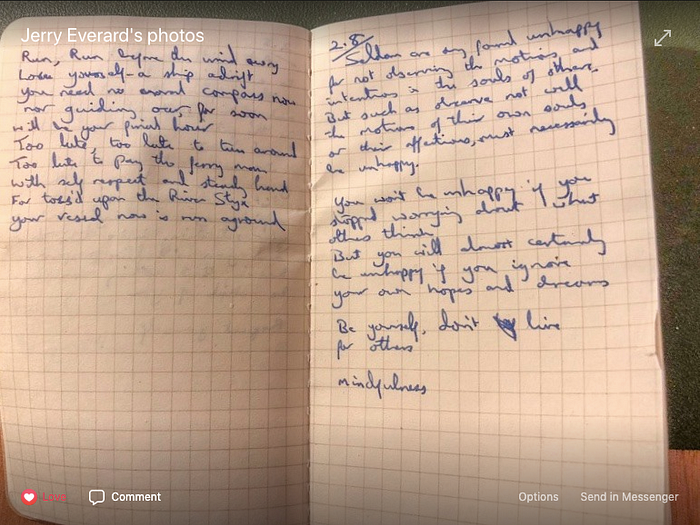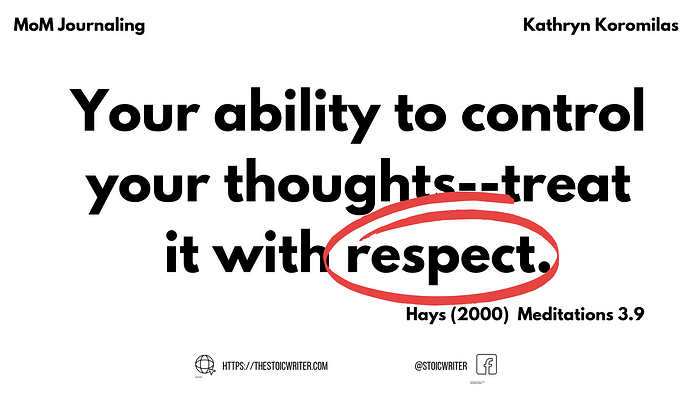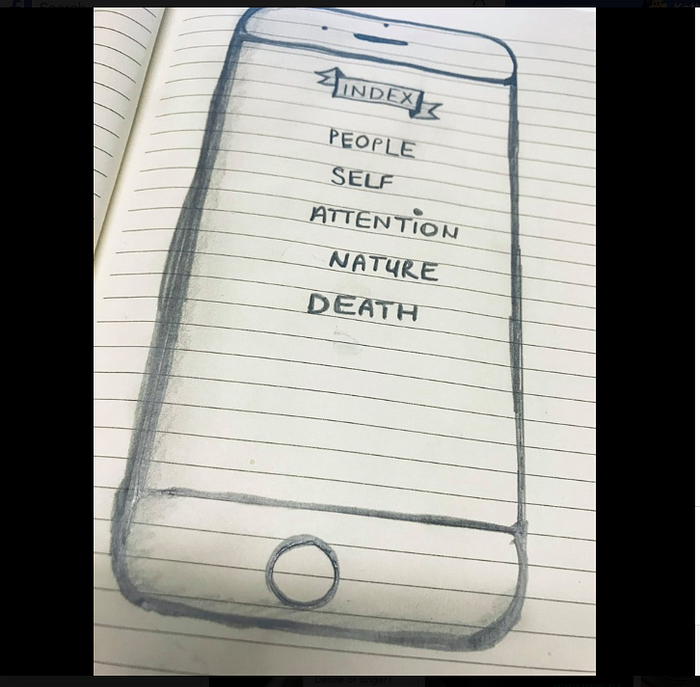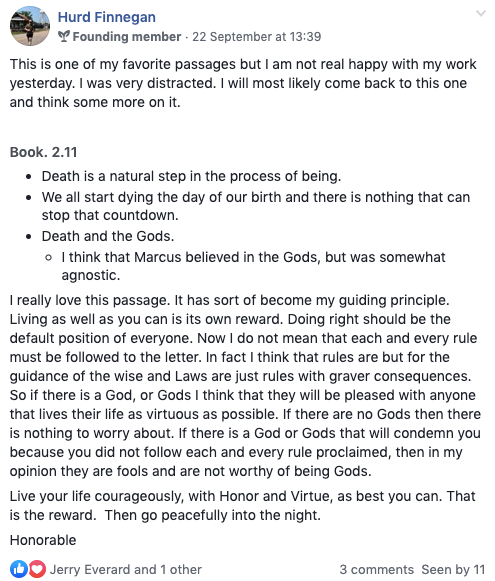Meditations on “Meditations”
Towards a more Stoic kind of journaling.
I presented this talk at Stoicon-X in Athens, Greece on Sunday, October 6 2019.

On Sunday 6 October 2019, I presented a half-hour session what I call “Meditations on ‘Meditation’” or “MoM” at the Stoicon-X Conference held on the day after Stoicon at Cotsen Hall, Athens Greece.
Here’s what I said about Meditations on “Meditations” (MoM).
If you’d like to try it yourself, please click here to apply to join the “Dead Good MoM” this November.
https://kathrynkoromilas.typeform.com/c/m5YoC9

What is MoM?
It’s a journaling practice. It’s a way of meditating with the Stoic texts by way of copying the texts, rewriting, reexpressing, reframing, reformulating the texts as inspired by Marcus Aurelius and the thinking and writing of Pierre Hadot, Michel Foucault and Gregory Hays.
Stoic writing and journaling online
In September last year, I set up The Stoic Writer and an accompanying Facebook page, the Stoic Writer page. I set up a Facebook group, the Stoic Writing Scene, and began posting prompts for fiction and non-fiction writing and journaling. In preparation for my presentation at Stoicon-X, last September I ran a MoM Journaling Bootcamp to “Beta” test this method of journaling.
About 23 participants signed up for the Bootcamp daily email and either worked privately or joined the Bootcamp Facebook group.

For 28 days in September, I sent out a daily email focusing on a specific meditation from the Marcus Aurelius, we started with Book 2:

Participants agreed to work through a specific set of writing activities:

I offered various options based on the time commitment we had each day:

About 10 participants committed to a daily practice of anywhere from 10–90 minutes per day of Stoic practice.
Two main obstacles to journaling
I surveyed the group at the beginning and at the end of the Bootcamp. In terms of a journaling practice, three main obstacles were brought up in survey answers:
- How to set up and sustaining a daily journaling or writing habit
- How to beat the blank page, writer’s block, lack of inspiration, what to write about, and
- How should a Stoic journaling practice even look and feel like?
What the Mom Journaling practice looks like
In brief, the “Meditations on ‘Meditations’” MoM daily writing/journaling practice looks and feels like this:
- Copying texts
- Summarizing texts
- Rewriting texts
- Reexpressing texts in your own voice, in poetry, in visuals
- Reframing texts to suit your needs, say in compiling your own Encheiridion or Handbook for life
And why coping, why rewriting?
To recompose the rules of life, the Stoic doctrines.
And why recomposition?
To reformulate the Stoic doctrines in the most striking and concrete way, that’s Pierre Hadot.
And why striking and concrete?
To make the teachings more memorable, so that you can memorise them and have them always at hand, always in your hand (as Epictetus himself recommended and as Arrian actually did).
And why keep the doctrine’s at hand?
So that we can be prepared “when an unexpected, and perhaps dramatic, circumstance occurs.”
And how to keep them at hand?
In one’s memory, by memorising, or if one’s memory is like mine (a kind of early-onset dementia), then as in a Encheiridion.

Some theory: Foucault, Hadot, Hays.
Michel Foucault wrote about ancient Greek notebooks, hypomnemata, as notes to the self, or a kind of self-writing. The content of these notes were simply restatements of the knowledge, doctrines, teachings.
Their purpose? To shape the self. A kind of ethical purpose. A practice towards the moral enhancement of the self.
So, this writing practice differed in content and purpose from later (Christian) journal writing which was/is, say, confessional. This type of writing or journaling differs from our contemporary practice which, I argue, is more storytelling. It’s where we position ourselves as the central protagonists in our drama of life and focuses on our own personal optimization or actualization project.
Okay, so that’s Foucault.
Next, Pierre Hadot. And I’m talking about his Philosophy as a Way of Life and specifically the chapter on “Spiritual Exercises.”
So, from Hadot, I get that our Stoic practice isn’t a philosophical exercise or intellectual exercise or a thought experiment or a brain hack. It’s a kind of complete and wholistic engagement for the purpose not just of controlling and changing our thoughts or but for transforming our vision from a personal, human vision to a natural and universial vision.

So from that, I see our practice’s aim is to result in a complete metamorphosis of our default personality setting (which as I suggested before is protagonistic, egoistic, it’s storytelling that positions us the hero or heroine in the drama of life in which we encounter a range of adverse situations and other personalities) so a transformation, from this default personality setting to a natural, universal vision of the world and our place in it. This more universal setting ties in with Stoic cosmology, physics, ethics and is thus fundamental to the Stoic psychology.
Okay, so that’s Hadot, spiritual exercises as the way towards complete metamorphosis of our entire psychism.
Third, Gregory Hays, who translated Marcus Aurelius in 2000. And basically this is from a single paragraph is his brilliant introducion to that translation. Hays says that Marcus Aurelius did no new, original philosophical work in the Meditations, but rather he rewrites, reexpresses, and reframes the Stoic doctrines.
Why does he do this?
According to Hays, this is what Marcus Aurelius finds helpful for his own Stoic practice, his own moral project. This practice of revisiting, circling back to the doctrines again and again.
Journaling or rumination?
So, to my own Meditations on Meditations, my own journaling. For a long time, I’d write free-form, long confessional narratives and while they helped me identify my emotions, map out complex social relationships, make sense of trauma, organize a past or future event in our mind they were also an open invitation to rumination.

So, I stopped free-form, long-form journaling for a long, long time and went back to Hadot and learnt that we have an idea of the types of writing activities the ancient Greeks did. So we have two lists of exercises which we’ve inherited from Philo of Alexandria and Hadot discusses then and then I’ve sort of curated them for my own purposes and here are three types of activities which have informed my own practice.

So we have exercises of attention, exercises of meditation and memorization and rhetorical amplification.

So writing activities that keep us close to the single-text, writing activities that are slow and meditative, writing activities that rewrite and reformulate to help with memorization, and writing activities that play with rhetorical tools to amplify the text, to turn up the volume so they can strike harder and be more memorable, easier to keep with us out in the wild.
So, the exercises.
- Personal response
- Copywork
- Word analysis and choice
- Bullet, sentence, and word summaries
- Rewriting, reexpressing, reframing
- Poemwork
- Voicework
- Artwork
- Community work
Personal response.
Really limited our reactive, personal writing and when we did it we quickly returned to and attended to the text. So here I’m reacting to Book 2.1, you know the one when you wake up be prepared to meet a whole lot of crazies…
Every morning — Arrrgghhh! Diana! She is rude. She is narcissistic. She’s a control freak and a micromanager. She makes my life at work so damn miserable every damn day. I am always on edge. Always angry.
So mine started like this (Diana was a boss; true story, names changed to protect the unStoic) but I’d start to limit rumination to 15 minutes and then go back to the text and bring in Marcus Aurelius.

Still, you can see there’s still a storytelling element to it —
me the heroine
she the enemy.
But how to pull myself out of that and how to limit my ruminating on paper and perform a writing practice that could help my psychic transformation?
So, to the “Meditations on ‘Meditations’” (MoM) activities:
Copywork
And when I say copywork, I literally mean copying the meditation, say Book 2.1, word for word. Copywork was a pedagogical tool used in th past, and that’s how children learnt to write. In fact, some of our favourite famous writers did copywork as a way of tapping into the lexical and syntactical characteristics of a writer they admired. Try it, it’s a wonderful way to listen to the rhythm and rhetoric of a text, as well as the logic of a text, so learning Stoic logic in this way too, but for our own spiritual practice it’s a way of letting go of the self and of just sitting with a text and listening to it, and attending to it, meditating on it, even working towards its memorization.
And, this is what our copywork looked like.

So, we all had a big messy notebook in which we did our copywork and our other journaling work.

And as you can see there are some other writing tools at play here too for the purpose was to somehow copy and then reformulate the doctrines in various ways so as to finally strike hard the psyche and slip into our own Encheiridia or Handbooks.

So, that’s copywork.
Word analysis and choice.
Next a comment on word analysis and choice.
Because our aim is to reformulate the doctrines into the most striking and concrete way for them to be memorable to us, then words and the connotations that linger around them is something we had to respond to.
Here’s a quick example I’ll describe, which is about a lexical choice I recently made and which I think, maybe, demonstrates what Hadot said about these spiritual practices being a way of shifting ourselves out of our personal vision to a universal one (to tying our visions of our personal nature to the universal nature as per the teachings of Stoic cosmology and physics and thus fundamental to the psychology of the Stoic).
Okay, the first sentence of Book 3.9.
Here is it in the Glasgow translation (this Bootcamp I used the Glasgow translation, completed in 1742 by two very important blokes of the Scottish Enlightenment, Hutcheson and Moor, I think it was cool reading this one as I’ve been living in Scotland).

So, cultivate with “care” that power which forms opinions. So, take care with your rational faculty, mind. Care. And, now to the George Long translation: “Reverence” the faculty which produces opinion. “Reverence.”

So, take a few seconds to feel how those two words resonate on your psyche. Which one resonates more? Remember, Hadot talked about rhetorical amplification, so turning up the volume on word choice, syntax so that the maxims sound more striking and concrete to your ear, your soul, your entire psyche. And here it is in the Gregory Hays, more familiar maybe to us: Your ability to control your thoughts — treat it with respect.

So, “respect.” How does that resonate with you?
Respect.
Care.
Reverence, which one strikes your psyche loud and clear?
So, respect resonated with me when I first reformulated the meditations:
So, one of the summaries/maxims that entered my Encheiridion (Version 1.0) back in March, (this one is Version 2.0):
Your mind? Respect!

I find this is a cute and sassy reformulation and, sort of, hip-hop (to my ear, at least). But a few weeks ago, during the September Bootcamp, I became sceptical of the word. There was a Pyrrhonist in the group and she made us doubt everything!
So, I went to back to Marcus Aurelius’s Greek. Here it is on the Perseus Digital Library which is a really cool way to access it because when you click on a word the Greek Word Study Tool opens up with a translation plus a whole lot of other fun stuff for scholarly distraction.

So, Marcus Aurelius uses the word SEBE which translates to worship and honour. Now, to me, a hardcore atheist, I shun all words in the Stoic texts that connote the religious, the sacred, the mysterious, so I reverted back to the use of the word respect.
How do these two words resonate with you?
If I linger with them longer, then something happens. Respect tends to be claimed by the personal qualities we demonstrate or acquire as individuals or by the role we play in our interpersonal relationships. So, my mother might have said sebasou ton patera sou. Respect your dad. Similarly, she’d respect her husband. Sebomai ton andra mou. And advise to me as a young girl — na sebese to kormi, respect your body. She never did say respect your mind.
Worship, on the other hand, is claimed by the religious and the sacred and the mysterious, and I feel “worship” or “reverence” is the more accurate term.
Is there room for mystery and the sacred for the atheist? Well, I’m actually taking a leap of faith towards science and while science promises transparency and truth, I’m no scientist. So in this way, yes, very much in awe of the fact of my mind, so yes, why not worship. Not worship my personal mind per se but worship this power I’ve somehow got!
So, yes, worship. This word now pulls me out of my own personal view of the power of my rational faculty and how I am personally responsible for its excellence, and shifts me towards a universal vision of my mind, our minds, such an awesome power, to be worshipped indeed.
Thus, my formulation Version 2.0. Worship your mind.

Saying that now, memorising that now, has a real impact, now it strikes and amplifies this doctrine.
Okay, moving on. Maybe you can see now that if nothing else, these exercises provide a framework for some sort of daily spiritual exercise in writing for our journaling practice and our continued spiritual engagement with the texts.
Summarising
Okay, so summarising. Another way of staying close and attentive to the text.
I feel that today, we (I) read and rush off to our journals to write about ourselves and our dramas (or maybe that’s just me) and end up reaching cathartic heights but maybe going off-topic?
What we did in the Bootcamp as mentioned was limiting our personal, free-form responses, and always coming back to the text and attending to it.
So, here I am bullet-pointing Book 2.1.
Say thus to thyself every morning: to day I may have to do with some intermeddler in other mens affairs, with an ungrateful man; an insolent, or a crafty, or an envious, or an unsociable selfish man. These bad qualities have befallen them through their ignorance of what things are truly good or evil. But I have fully comprehended the nature of good, as* only what is beautiful and honourable; and of evil, that it is always deformed and shameful; and the nature of those persons too † who mistake their aim; that they are my kinsmen, by partaking, not of the same blood or seed, but of the same ‡ intelligent divine part; and that I cannot be [63] hurt by any of them, since none of them can involve me in any thing dishonourable or deformed. I cannot be angry at my kinsmen, or hate them. We were formed by nature for mutual assistance, as the two feet, the hands, the eye-lids, the upper and lower rows of teeth. Opposition to each other is contrary to nature: All anger and aversion is an opposition.
• Wake up. Pause. Think.
• Prepare to deal with people.
• Some will be bad.
• You are good.
• You can see the bad are the same as you.
• So, it’s not natural to be angry at them.
• You were all born to work together.
And so on and so on. And you can maybe see or hear that my voice is coming through and I’m already feeling about for rhythm and structure —
some are bad;
you are good.
And then, proceeding to tap into the essence (where possible, because not all meditations are composed with a single clear idea).
Deal with people. We are born to work together.
And onwards to a single word, a keyword summary.
People.
And these keywords were important and interestingly everyone’s keywords were different but always important not just for organizing the thematic concerns of the meditations but because we were hoping to curate and compile a practical handbook, an Encheiridion we could use in the “wild” then we’d need to make it a practical tool that could be quickly and easily navigated.
So, we looked at how to index our reformulations.
Here’s an early draft of an index of Book 2, which I sketched in my big, messy notebook.

So, I’m thinking my Encheiridion Version 2.0 will be organized according to the problems and anxieties I have in the world: my anxieties about meeting people, my anxieties about my self, my anxieties about my attention and, mostly, distraction, my anxiety about my nature and my anxiety, my fear of death.
Okay, so, from our summaries we then rebuilt the text into prose form.
Rewriting, reexpressing, reframing
And here’s my reexpression of Book 2.1, and this is really starting to sound like me, writing my own notes to myself, and I just want to focus those words in red. Bad, Bad, and badness. I’ve simply replaced the word “evil” in the translations with “bad.” Again, to my atheism, the word “evil” is too weird, and because I need to keep the text close to me (while at the same time not changing the subject of what Marcus Aurelius is saying) I need to find the most striking and concrete lexical choice.

And here’s another image of what our writing practice looks like. So, big messy notebook for copywork, summaries, reexpressions; index cards for reformulating again, and on the left there the open and ready notebook waiting to become a living and working Encheiridion tucked into our hands, or in my case, my handbag!

And here is Brian’s work off Facebook. The messy notebooks, the Hays, he worked between two translations, and the index cards, and the notebook. This is a notebook he purchased about 15 years ago and had yet to dare write in it, it’s so beautiful. I too purchased my own tartan covered notebook when I moved to Scotland back in December and left it empty until this auspicious moment!
Here is Brian’s rewritten Book 1.7 on Facebook with our little community engaging unStoically with Facebook emoticons.

And here is Brian’s work off Facebook. The messy notebooks, the Hays, he worked between two translations, and the index cards, and the notebook. This is a notebook he purchased about 15 years ago and had yet to dare write in it, it’s so beautiful. I too purchased my own tartan covered notebook when I moved to Scotland back in December and left it empty until this auspicious moment!
And here is Alan Cornwall who managed to beat the fear of the blank page by doing the groundwork in the messy notebook and then tidily rewriting on the computer, printing, and pasting.

Poemwork, Voicework, Artwork
Okay, and now for a couple of more creative options for reformulation. We wrote poems. Alan excelled with the Haiku form and he’s next going to curate a Handbook of Stoic Haiku for his own pleasure and spiritual practice.

We also looked at voicework, recording our own audio files and artwork, creating Facebookable, instagrammable, and even wall art for our striking and memorable reformulated maxims.
So, I produced one of these with various templates and fonts, but the moment I discovered this font — it’s League Spartan and it’s available on the Canva app) — I was stunned, my psyche was completely transfixed. This is the quintessential Stoic font. So, visual and audio rhetoric for our spiritual practice.

Here’s another lovely creation which demonstrates just one exploration and practice of rhetorical tools, here; repetition.

And you only have one life. And yours is almost done. And yours is almost done. And you only have one life. And yours is almost done.
Finally, one of the most instagrammable of the meditations is 2.17 in the Hays translation. Do go and compare the Hays translation of 2.17 with the Long or other translation. Hays does something remarkable here: he almost bullet-points the first section of the meditation which is about the characteristics of our human life. And here it is in the Stoic font!

For me, this is one of the most gut-wrenching of the Meditations (sorry that’s the tragic Stoic coming back) rendered here so striking and so utterly concrete to make it stunningly memorable to my psyche.
Community work
Now to the final activity: community work. Stoicism is, after all, a very social philosophy! We shared some striking moments on our little online Stoa. In the noise of Facebook, we found we could use the tools there to be the social Stoics we ought to be. So we shared a few Facebook Lives, some videos and images from our lives and our Stoic moments in our own life, here’s a 20-minute video of me driving behind a hearse. I shared it with the group and that became part of the meditation activity for that day. This was book 7.56.

And we discussed both the content of the meditations but also our own process, our wins and our difficulties in reformulating the meditations.

We also had some good laughs and here’s Mary Braun who was our resident Pyrrhonist saying: This is the first time I wish Marcus had an editor!



Kathryn Koromilas is an author and educator. A lifetime student of philosophy and literature, she has degrees in philosophy, literature, education, and creative writing. As an educator, she’s taught online and at colleges and universities in Australia and the United States. She’s also taught in China, Greece, and Spain. As a writer, she’s written everything from philosophical fiction and travel essays to reviews of books and jazz musicians. She lived near the ancient Nikopolis where Epictetus taught philosophy. Oh, and she met Jacques Derrida in Athens and asked a question about philosophical hypocrisy…but she was younger and bolder then. x
